Excavation Contractors Anderson
Find top Excavation Services in Anderson
Receive up to 3 Trenching Services quotes for your project today! Compare profiles, reviews, accreditations, portfolio, etc... and choose the best service.

Land Clearing Services Inc
52 reviewsP.O. Box 1009, Blythewood, SC, P.O. Box 1009Blythewood, 29016, USHelping You Get the Job Done Right Anywhere, Anytime! Experienced Clearing, Grinding, Tree Removal and Disaster Contractor CONTACT US TODAY Welcome to Land Clearing Services Helping You Get the Job Done Right Anywhere, Anytime! Planning on clearing a piece of land filled with brush and trees? Contact us today for a free quote! Land Clearing Services is a fully insured and qualified land clearing company with 19 years of experience. We offer all types of clearing, grinding and tree removal services, along with most forms of sitework. We clear and grind anywhere in the southeast and offer state-of-the-art brush cutting equipment for contractors, developers, governments, co-ops, and property owners. Our company saves time over other companies through the use of highly experienced operators and late model equipment. When you want the job done right the first time, contact us. There is no job too large or too small for our company. If you need a safe, consistent contractor, we have you covered. We offer Tub and Horizontal grinders, stump shears, excavators, dozers, mulchers, loaders, haul trucks, dump trucks, walking floors, etc. Call us for a quote on your next job. Land Clearing Services is dedicated to providing the highest quality, time-saving, and safest services for the clearing and grinding market. With over 19 years of experience, we know what equipment you'll need, and we provide everything to make your land clearing project more efficient. We provide everything from tree removal to grinding to haul off in our services. If you have a project you would like to clear, contact Land Clearing Services for high-quality service with the experience to get your job done. WE ARE A LOCALLY OWNED AND OPERATED BUSINESS IN LUGOFF, SC. WE SERVICE ALL OF SOUTH CAROLINA, NORTH CAROLINA, GEORGIA, FLORIDA, ALABAMA, TENNESSEE! Want to join our team at Land Clearing Services? apply online! Land Clearing, Tree Removal & Disaster Services Land Clearing Services offers late model equipment. Our employees are both experienced and motivated. We are MSHA certified and have experience working on various mine sites. Also, we have worked Gas lines and Transmission and Distribution lines. Commercial and residential tract clearing Fuel reduction Wildlife Habitats Storm Cleanup Riding Trails Pasture reclamation Fire breaks Slash/clear-cut cleanup Site Grinding Development clearing R.O.W. Real-estate Improvement disaster services Land Clearing Services offers a quick response time and sufficient equipment to respond to any type of Natural disaster within the Southeastern United States. We provide a competent team of understanding employees which have the skills necessary to quickly remedy the problem at hand. Our business is based on a WIN-WIN approach. We like to make sure our customers’ needs are met with each project and ours as well. Past Storms include: Wilma, Matthew, Florence, Michael, Irma, Laura. Our specialty is site grinding! Site Management Site Grinding Site Cleanup Dump trucks Excavators Self loaders Hauling of debris Horizontals & Tub grinders Wheel loaders Dozers Walking Floor Trailers Dump trailers (large tractor type) Managing area crews
- Services
- Why Us?
- Gallery
Get Quote
Nebcon Inc
4.111 reviews2026 Keystone Drive, Omaha, 68134, USIntroduction Since 1997, Nebcon, Inc. has completed hundreds of projects successfully throughout the Midwest. Nebcon, Inc's reputation has been built on our ability to find solutions to problems and tackle any project. No matter how challenging the conditions or demanding the deadlines we continue to grow an already large customer base by presenting the best plan for every project. Our unique brand of integrity makes us true partners with our customers who benefit from our ability to provide an objective analysis of every aspect of a project. We are able to identify and solve problems before they become costly delays in the field. Our Team Our team of professionals prides themselves on getting the job done right... anywhere... and at anytime. Whether splicing cable in rural Iowa or designing geothermal loop systems in Omaha, Nebcon, Inc has what it takes! With over 20 years in the industry, we know that our customers come first. That's why so many customers rely on our vast experience and state-of-the-art expertise for all their projects. Our reliability, dedication to service and excellence has made Nebcon, Inc. one of the most comprehensive providers of quality installations... and system reliability ... to all our customers. Our Commitment Nebcon, Inc. has the right people, the right equipment and the right knowledge to get the job done!!!
- Services
- Why Us?
- Gallery
Get Quote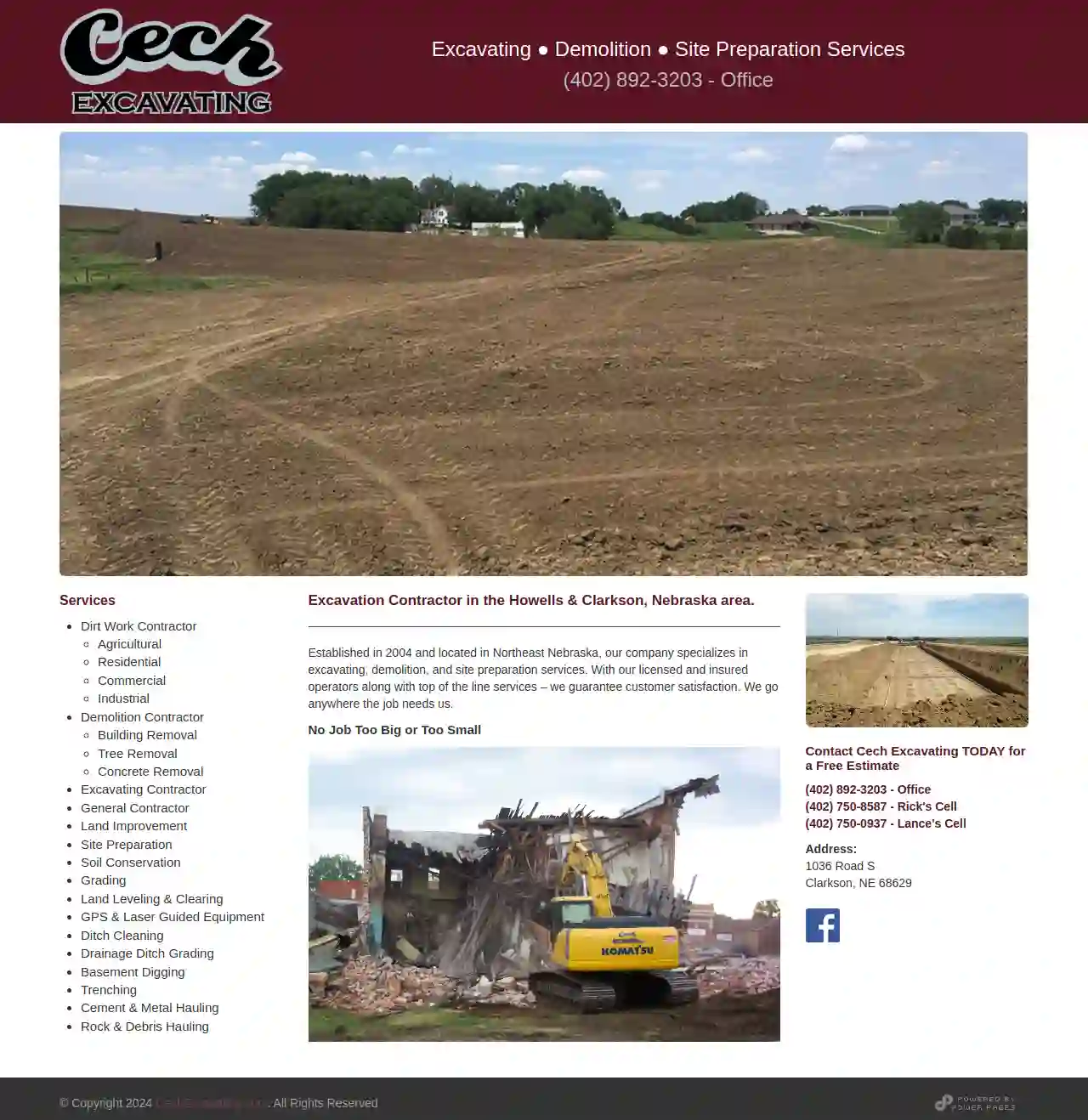
Cech Excavating LLC
1036 Road S, Clarkson, 68629, USCech Excavating: Your Trusted Partner for Excavation, Demolition, and Site Preparation Established in 2004 and based in Northeast Nebraska, Cech Excavating has built a reputation for excellence in excavating, demolition, and site preparation services. We are committed to providing our clients with the highest quality workmanship and customer service, ensuring their complete satisfaction. Our team of licensed and insured operators utilizes top-of-the-line equipment to deliver efficient and reliable results on every project. We understand that every project is unique, and we take pride in our ability to handle projects of all sizes. Whether you need a small residential excavation or a large-scale commercial demolition, we have the expertise and resources to get the job done right. At Cech Excavating, we go the extra mile to ensure your project is completed on time and within budget. We are dedicated to providing our clients with a seamless and stress-free experience. Contact us today for a free estimate and let us help you bring your vision to life.
- Services
- Why Us?
- Our Team
- Gallery
Get Quote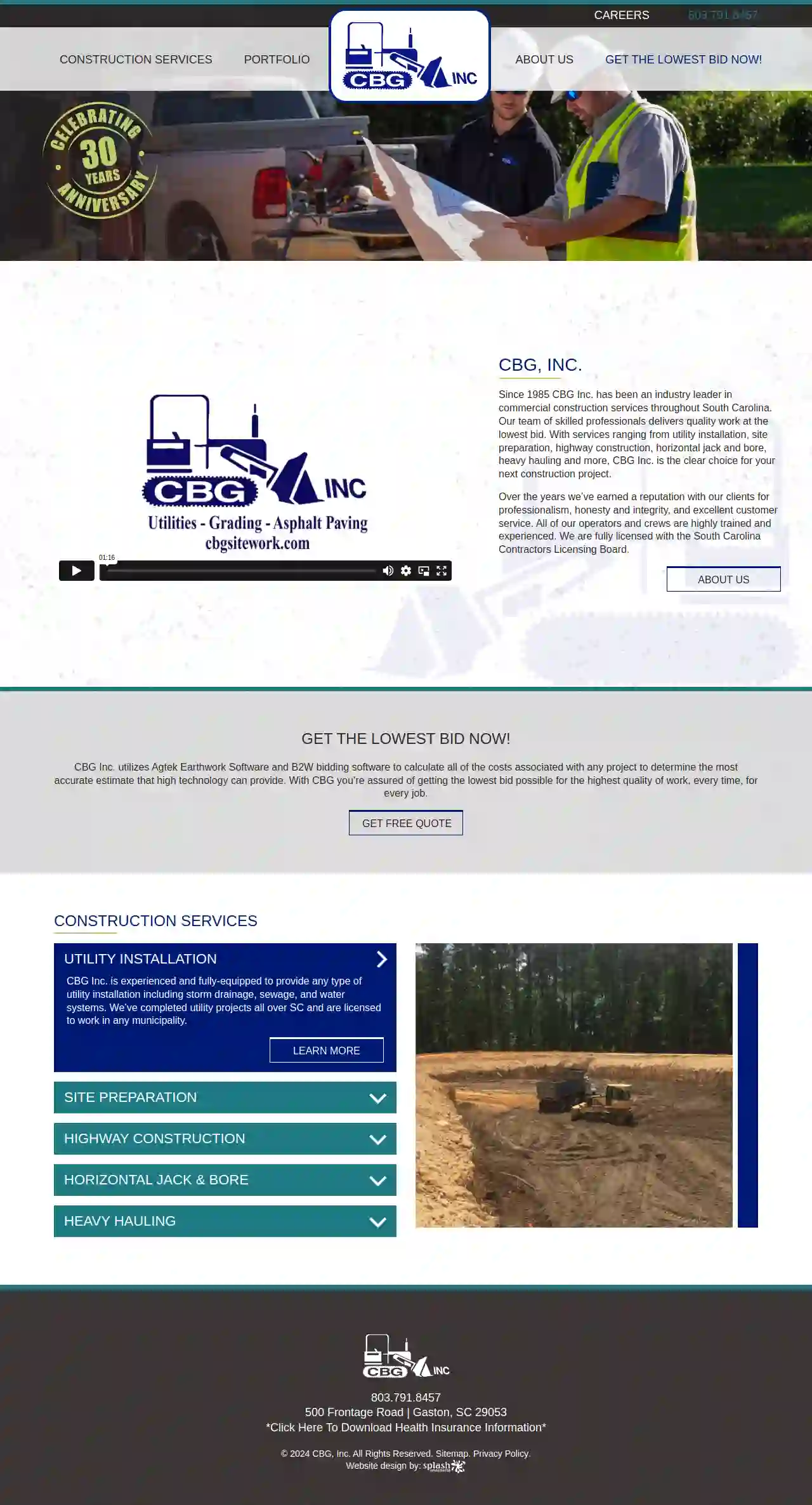
CBG Inc
4.715 reviews500 Frontage Road, Gaston, 29053, USAbout CBG, Inc. Established in 1985, CBG Inc. has become a leading provider of commercial construction services throughout South Carolina. Our team of skilled professionals is dedicated to delivering high-quality work at the most competitive prices. We offer a comprehensive range of services, including utility installation, site preparation, highway construction, horizontal jack and bore, heavy hauling, and more. CBG Inc. is your one-stop shop for all your construction needs. Over the years, we've built a strong reputation for professionalism, honesty, integrity, and exceptional customer service. Our operators and crews are highly trained and experienced, ensuring that every project is completed to the highest standards. We are fully licensed with the South Carolina Contractors Licensing Board, providing you with peace of mind and assurance. CBG Inc. utilizes advanced technology to ensure quality work at the lowest price possible. We employ Agtek Earthwork Software and B2W bidding software to accurately analyze projects and calculate costs, ensuring you receive the most competitive bid. With CBG, you can be confident that you're getting the best value for your investment. We are proud of our team and our commitment to providing exceptional service to our clients. We attribute much of our success to our dedicated employees and loyal customers. Contact CBG Inc. today for a free quote and let us help you bring your next construction project to life.
- Services
- Why Us?
- Gallery
Get Quote
Anderson Contracting & Environmental Septic LLC
Anderson, USOur Story Anderson Contracting & Environmental Septic LLC is known for quality services, exceptional efficiency and the highest level of professionalism. No matter what service you’re looking for, we guarantee to not only meet, but exceed your expectations and ensure your full satisfaction. Our team brings years of experience in the water and wastewater industry, from both the private and public sector. Our goal is to give our customers and clients accurate and unbiased information about their onsite systems and how we can help. Implementing solutions that will last for many years to come. Our team is up for every job, with the skill and experience our clients have come to expect. Please get in touch to learn more about our team, our company or for details about the services we provide.
- Services
- Why Us?
- Our Team
- Gallery
Get Quote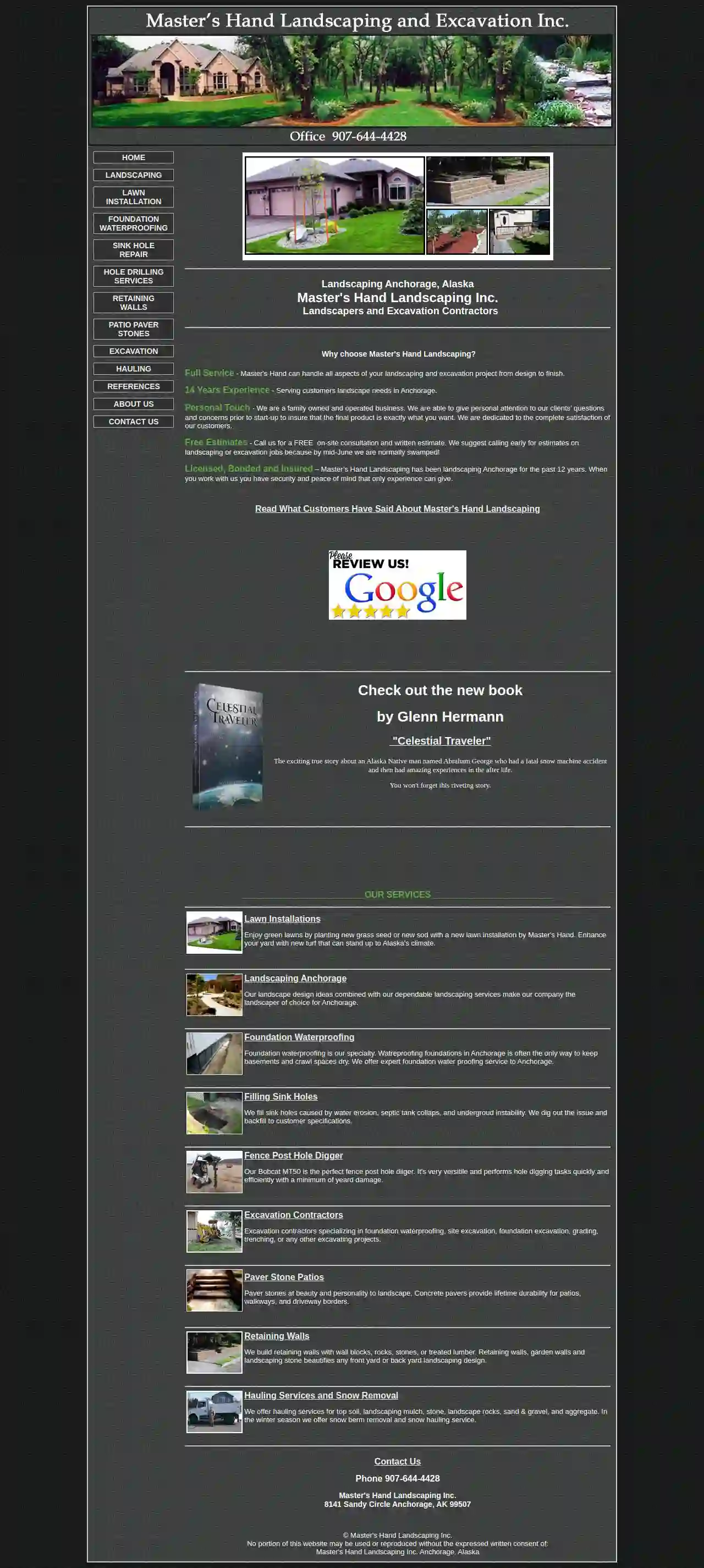
Master's Hand Landscaping and Excavation
4.814 reviews8141 Sandy Circle, Anchorage, 99507, USWhy choose Master's Hand Landscaping? Master's Hand Landscaping is a family owned and operated business serving Anchorage, Alaska for over 14 years. We offer a full range of landscaping and excavation services, from design to completion. We are dedicated to providing our clients with a personal touch and ensuring their complete satisfaction. We are licensed, bonded, and insured, giving you peace of mind that only experience can provide. We offer free estimates and on-site consultations. Call us early for estimates on landscaping or excavation jobs, as we are often busy during the peak season. We are committed to providing high-quality services and exceeding our clients' expectations. We are proud of our work and our reputation in the Anchorage community.
- Services
- Why Us?
- Gallery
Get Quote
Augusta Industrial Services, Inc.
1428 Lovers Lane, Augusta, 30901, USFast. Safe. Reliable. When you need to keep things running smoothly, call in the pros. Augusta Industrial Services is a leading provider of industrial and environmental services. We offer a wide range of services to meet the needs of our customers, including vacuum excavation, hydroblasting, sewer cleaning, emergency response, and more. We are committed to providing our customers with the highest quality services, delivered safely and efficiently. Our team of experienced professionals is dedicated to meeting your needs and exceeding your expectations. We are proud to serve a wide range of industries, including construction, manufacturing, and utilities. We are also committed to providing our customers with the best possible customer service. We are available 24/7 to answer your questions and provide you with the support you need. Don’t take our word for it. See what our customers have to say: Maintenace Coordinator Please extend my thanks to the staff at Augusta Industrial Services for the support of the Site Infrastructures group. Augusta Industrial Services has performed many emergent jobs for us in such a timely manner to minimize the impact during hazardous weather and unexpected conditions. AIS management has worked with us to help us as a group to understand the needed scope, coordinate times, and provide input to ensure success. Site Technical Representative As an STR it is our job to perform safety oversight. At each visit to the field, I found that all Augusta Industrial workers had all proper PPE in place, the job barricaded properly to protect outside personnel and the assigned workers were very professional in explaining their procedure to me. It was a pleasure to work with the professional group that was assigned to this project. Thanks for your contribution to the overall safety and completion of this project. Contract Monitor In addition to saved costs and schedule, the work was performed expertly and with safety being the primary consideration. It was evident from the Safety Plan that Augusta Industrial provided that all potential hazards had been identified and proper controls put in place to execute this work at the level of safety expertise required at this site. We’ve got you covered. Day or night, we’ll be there when you need it.
- Services
- Why Us?
- Testimonials
- Gallery
Get Quote
Rolle's Enhanced Land Clearing & Lawn Care Services
1000 Rollens Rd, Statesboro, 31408, USAbout Rollens Enhanced Land Clearing Rollens Enhanced Land Clearing is a family-owned and operated business with over 20 years of experience in the land clearing industry. We are committed to providing our clients with the highest quality service and workmanship. We are fully licensed and insured, and we are dedicated to safety and environmental responsibility. Our team of experienced professionals is equipped with the latest technology and equipment to handle any land clearing project, big or small. We offer a wide range of services, including: Site preparation Tree removal Brush clearing Land grading Demolition And more! We are committed to providing our clients with a smooth and efficient experience. We work closely with our clients to understand their needs and ensure that their project is completed on time and within budget. We are proud of our reputation for quality, reliability, and customer satisfaction. Contact us today for a free consultation.
- Services
- Why Us?
- Testimonials
Get Quote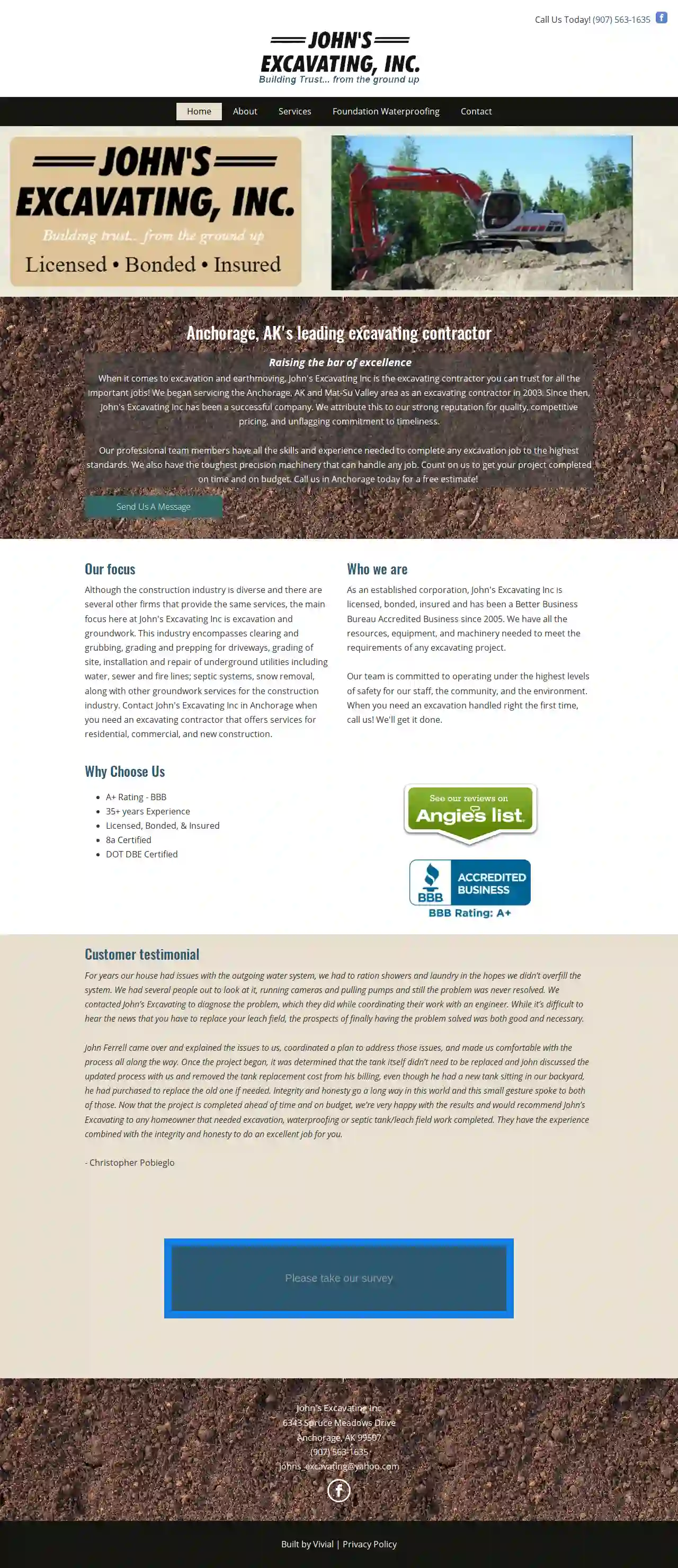
John's Excavating Inc
4.69 reviews6343 Spruce Meadows Drive, Anchorage, 99507, USRaising the bar of excellence When it comes to excavation and earthmoving, John's Excavating Inc is the excavating contractor you can trust for all the important jobs! We began servicing the Anchorage, AK and Mat-Su Valley area as an excavating contractor in 2003. Since then, John's Excavating Inc has been a successful company. We attribute this to our strong reputation for quality, competitive pricing, and unflagging commitment to timeliness. Our professional team members have all the skills and experience needed to complete any excavation job to the highest standards. We also have the toughest precision machinery that can handle any job. Count on us to get your project completed on time and on budget. Call us in Anchorage today for a free estimate! Our focus Although the construction industry is diverse and there are several other firms that provide the same services, the main focus here at John's Excavating Inc is excavation and groundwork. This industry encompasses clearing and grubbing, grading and prepping for driveways, grading of site, installation and repair of underground utilities including water, sewer and fire lines; septic systems, snow removal, along with other groundwork services for the construction industry. Contact John's Excavating Inc in Anchorage when you need an excavating contractor that offers services for residential, commercial, and new construction. Who we are As an established corporation, John's Excavating Inc is licensed, bonded, insured and has been a Better Business Bureau Accredited Business since 2005. We have all the resources, equipment, and machinery needed to meet the requirements of any excavating project. Our team is committed to operating under the highest levels of safety for our staff, the community, and the environment. When you need an excavation handled right the first time, call us! We'll get it done.
- Services
- Why Us?
- Accreditations
- Our Team
- Testimonials
- Gallery
Get Quote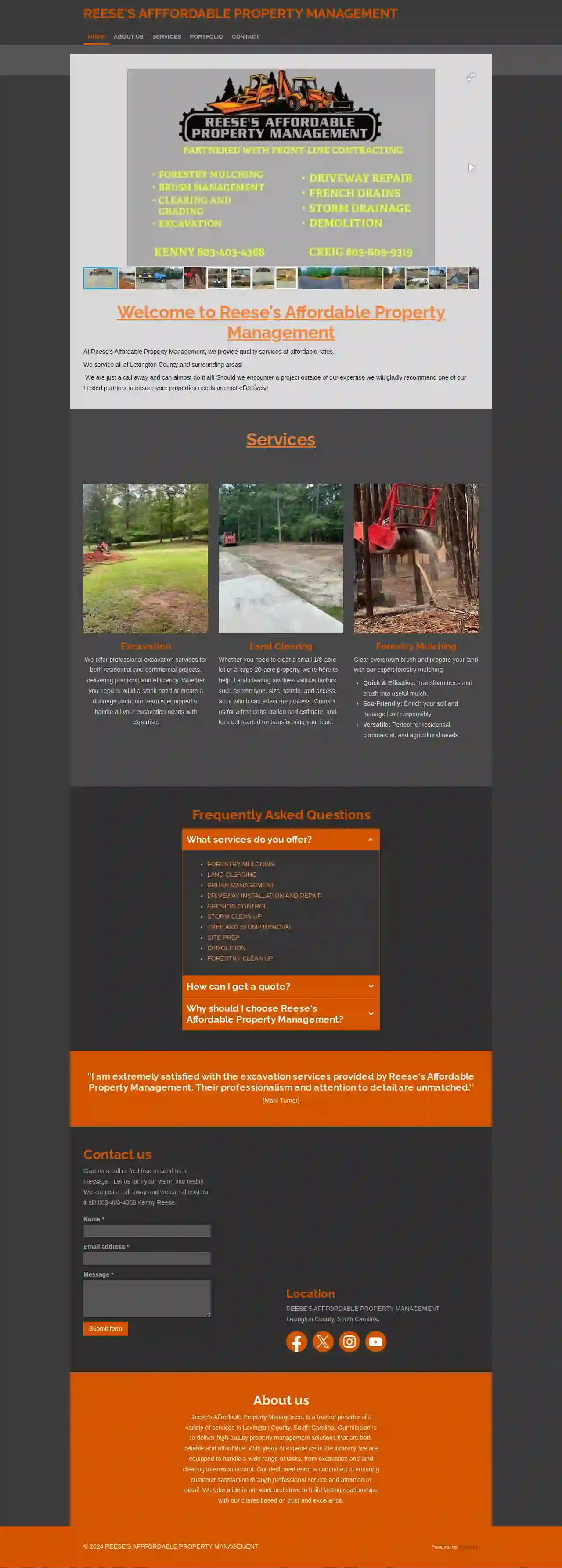
Reese’s Affordable Property Management
52 reviewsLexington County, USAbout Reese's Affordable Property Management Reese's Affordable Property Management was established in 2020. We offer a variety of services to Lexington County and surrounding areas. Best of all we offer Quality property services at affordable rates. We are a family-owned and operated business committed to providing our clients with the highest quality services at affordable rates. We understand that your property is an important investment, and we are dedicated to providing you with the peace of mind that comes with knowing that your property is in good hands. Our team is experienced and knowledgeable in all aspects of property management, and we are always available to answer your questions and address your concerns. We are also committed to providing our clients with excellent customer service. We believe that our clients should be treated with respect and courtesy, and we strive to make the property management process as easy and stress-free as possible. If you are looking for a reliable and affordable property management company, we encourage you to contact us today. We would be happy to discuss your needs and provide you with a free quote.
- Services
- Why Us?
- Our Team
- Testimonials
- Gallery
Get Quote
Over 22,076+ Excavation Companies on our directory
Our excavation companies operate in Anderson & beyond!
ExcavationHQ has curated and vetted Top Excavation Businesses in and around Anderson. Find a top & reliable contractor today.
Frequently Asked Questions About Excavation Contractors
- Topsoil Removal: Stripping the fertile topsoil layer from a site, often preserving it for landscaping.
- Trench Excavation: Digging long, narrow trenches for utilities (pipes, cables) or foundations.
- Basement Excavation: Removing earth to create a space for a basement beneath a structure.
- Pool Excavation: Digging a precise hole for installing a swimming pool.
- Roadway Excavation: Removing earth and preparing the ground for road construction.
- Demolition Excavation: Clearing debris and preparing the site after demolition.
- Channel Excavation: Creating channels for drainage or irrigation.
- New Construction: Laying foundations, basements, or underground utilities for new buildings.
- Home Additions: Creating space for new rooms, basements, or extensions.
- Landscaping: Leveling ground, creating slopes, installing retaining walls, or digging for ponds or pools.
- Drainage Improvement: Installing French drains, drainage ditches, or swales to manage water runoff.
- Utility Installation or Repair: Laying new water, sewer, gas, or electrical lines, or repairing existing ones.
- Demolition: Clearing debris and preparing the site after demolishing a structure.
- Spring and Fall: Often considered favorable due to moderate temperatures and drier soil conditions.
- Summer: Can be suitable, but hot weather can make working conditions challenging and might require additional measures (shade, hydration) for workers.
- Winter: Excavation in winter can be more difficult due to frozen ground, snow, and potential delays caused by inclement weather. It might also require specialized equipment or techniques.
What is the difference between cut and fill excavation?
Cut: Involves excavating soil from an area where the existing grade is higher than the desired grade.
Fill: Refers to using the excavated soil ('cut' material) to raise the grade in an area where the existing grade is lower than desired.
This method minimizes the need to import or export soil, reducing costs and environmental impact. It's commonly used for site preparation, road construction, and landscaping.
What are the different types of excavation?
How do I know if I need excavation for my project?
What is the best time of year for excavation?
What is the difference between cut and fill excavation?
Cut: Involves excavating soil from an area where the existing grade is higher than the desired grade.
Fill: Refers to using the excavated soil ('cut' material) to raise the grade in an area where the existing grade is lower than desired.
This method minimizes the need to import or export soil, reducing costs and environmental impact. It's commonly used for site preparation, road construction, and landscaping.
What are the different types of excavation?
- Topsoil Removal: Stripping the fertile topsoil layer from a site, often preserving it for landscaping.
- Trench Excavation: Digging long, narrow trenches for utilities (pipes, cables) or foundations.
- Basement Excavation: Removing earth to create a space for a basement beneath a structure.
- Pool Excavation: Digging a precise hole for installing a swimming pool.
- Roadway Excavation: Removing earth and preparing the ground for road construction.
- Demolition Excavation: Clearing debris and preparing the site after demolition.
- Channel Excavation: Creating channels for drainage or irrigation.
How do I know if I need excavation for my project?
- New Construction: Laying foundations, basements, or underground utilities for new buildings.
- Home Additions: Creating space for new rooms, basements, or extensions.
- Landscaping: Leveling ground, creating slopes, installing retaining walls, or digging for ponds or pools.
- Drainage Improvement: Installing French drains, drainage ditches, or swales to manage water runoff.
- Utility Installation or Repair: Laying new water, sewer, gas, or electrical lines, or repairing existing ones.
- Demolition: Clearing debris and preparing the site after demolishing a structure.
What is the best time of year for excavation?
- Spring and Fall: Often considered favorable due to moderate temperatures and drier soil conditions.
- Summer: Can be suitable, but hot weather can make working conditions challenging and might require additional measures (shade, hydration) for workers.
- Winter: Excavation in winter can be more difficult due to frozen ground, snow, and potential delays caused by inclement weather. It might also require specialized equipment or techniques.